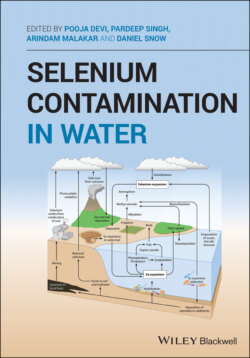Читать книгу Selenium Contamination in Water - Группа авторов - Страница 12
1.1 Introduction
ОглавлениеSelenium contamination is worldwide phenomenon. Contamination of selenium in surface and ground water in river basins is one of the critical problems nowadays.
As selenium shows a narrow tolerance limit (40–400 mg/day), the problem of both deficiency and toxicity of Se have being identified in many parts of India and the world (WHO 2009). Different countries are making efforts to remove selenium from water using different technologies. Some specific processing technologies include reduction, bioremediation, phytoremediation coagulation, electro‐coagulation, co‐precipitation, electric kinetics, adsorption, chemical precipitation, and membrane technology.
In periodic table, selenium (Se) lies between sulfur and tellurium in Group VIA and between arsenic and bromine in Period 4. Selenium originated from the Greek word “Selene,” which means “moon.” It was discovered in 1817 by Jo¨ns Jacob Berzelius, “Father of Swedish Chemistry,” during the manufacturing of sulfuric acid, when he observed and analyzed a red deposit on the wall of lead chambers (Tinggi 2003). Selenium, mostly in combination with minerals that contain sulfur, is found in the Earth's crust. It generally exists in four oxidation stages, i.e. elemental selenium, selenites, and selenates. The oxidation states of the selenium found in nature are −2, 0, +4, or +6. Selenium is an essential micronutrient for its development and reproduction for humans, insects, fish, and many other species, but is known often to be toxic in amounts beyond the acceptable limits (Stadtman and TC 1978). Selenium's Acceptable Limit (AL) for groundwater is fixed at 0.01 mg/l (ppm) by the Bureau of Indian Standards (BIS). The spectrum of selenium consumption for optimum human and animal safety is very narrow, meaning that low selenium consumption is correlated with developmental defects and disease and a high amount of selenium contribute to toxicity (Reilly 2006; Kurokawa and Berry 2013). It is required for healthy joints, heart, and eyes. Its role in DNA synthesis, the immune system, and the reproductive system is of critical value. A well‐known example of selenium toxicity is Keshan disease in Hubei Province, China, where several deaths have been reported (Yang and Xia 1995; Kipp 2015). Selenium is primarily found in water as selenate (SeO42−) and selenite (SeO32−). Among the two compounds, selenate is the more stable and thus comparatively difficult to remove from water solutions. Different physiochemical qualities, including oxidation reduction, pH, their chemical types, and sorbing surfaces, regulate selenium in soils or irrigation waters (Mondal et al. 2004). While being widely used in the production of photocells, rectifiers, photocopy machines, paints, crystal glass, and pesticides, it is extremely hazardous if found in drinking water exceeding 10 μg/l where the extent of selenium use for industrial applications comprising electronics, photocopying machinery, glass, rubber, etc. varies from 1 to 7000 μg/l. Proclamation of selenium adulteration to the surroundings is frequently connected with copper casting accomplishments. Selenium can enter water supplies through interaction with selenium carrying minerals or through contact with polluted soil or from emancipation from excavations, earthen deposits, discharge from factories, or from agricultural overflow escaping natural selenium amalgams from desiccated, undeveloped terrestrial areas. Selenium (Se) compounds in groundwater have attracted the attention of scientists due to the increased contamination as result of increasing industrialization and activities like mining, combustion of coal, and use of selenium‐contaminated water for irrigation (Luoma and Presser 2009; Gibson et al. 2012). Selenium generally enters the food chain through both surface and underground waters which are used for irrigation and drinking purposes (Dhillon and Dhillon 2003; Zhang et al. 2014).
The objective of this chapter is to discover the noteworthy research going on in this domain using a scientometric approach and visualization tools. This study explores the most‐cited investigations, authors, institutions, and countries since 2000. It also presents insights about the leading technological developments in the removal of selenium.
This chapter systematically reviews high‐impact literature to identify, evaluate, and interpret the work of researchers, scholars, and practitioners so as to develop insights into various removal methods, such as sedimentation, filtration, activated carbon adsorption, ion exchange, reverse osmosis, and biological techniques for removing selenium from water and wastewater.
